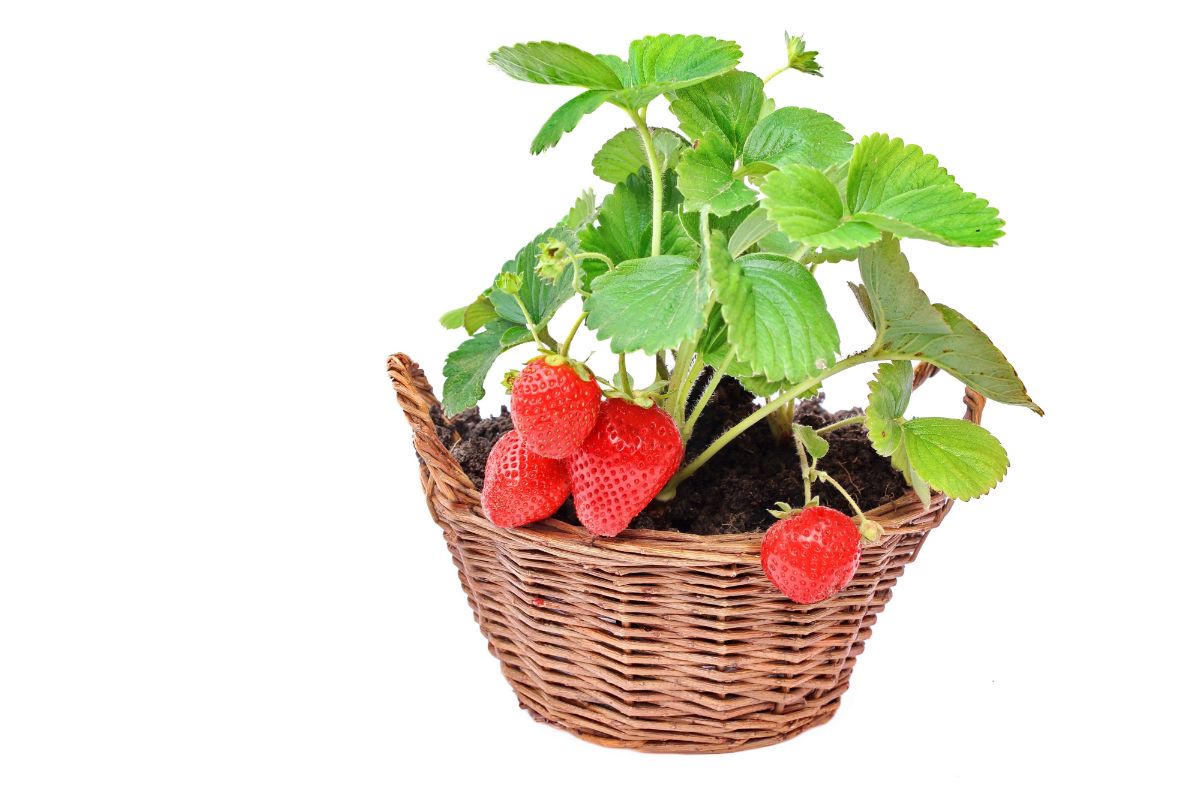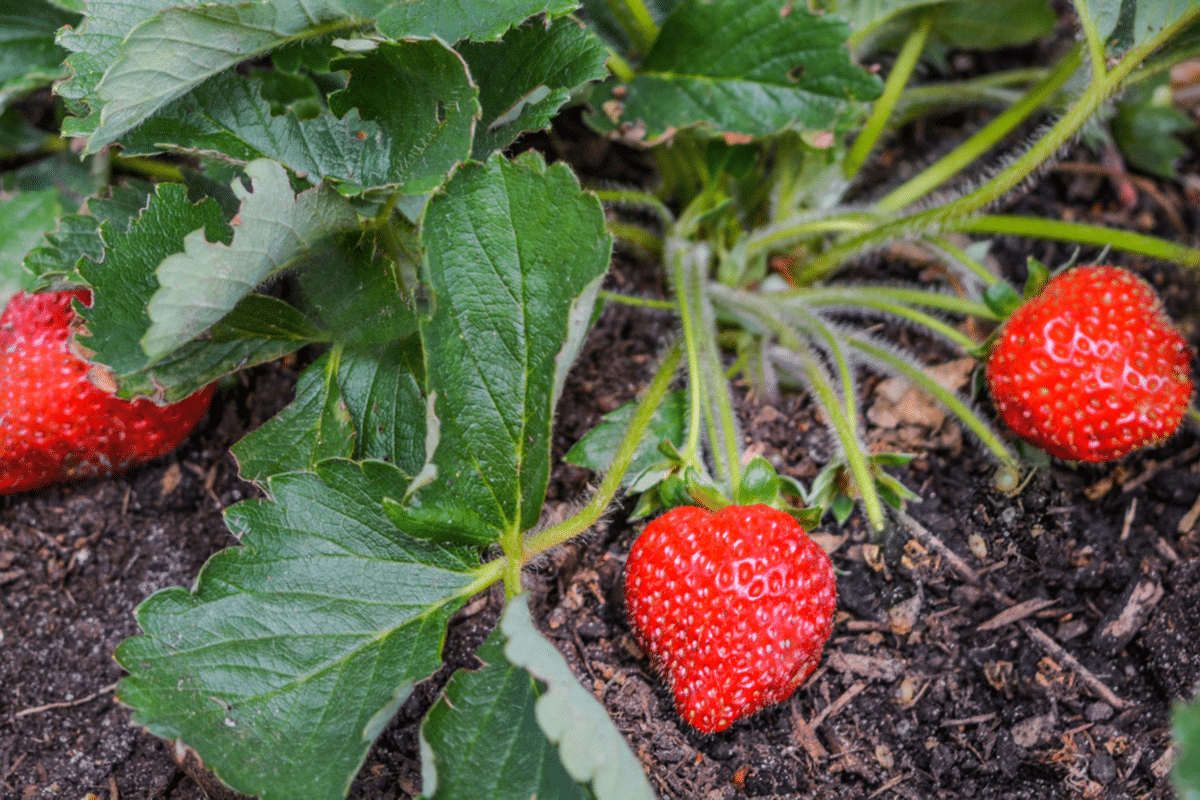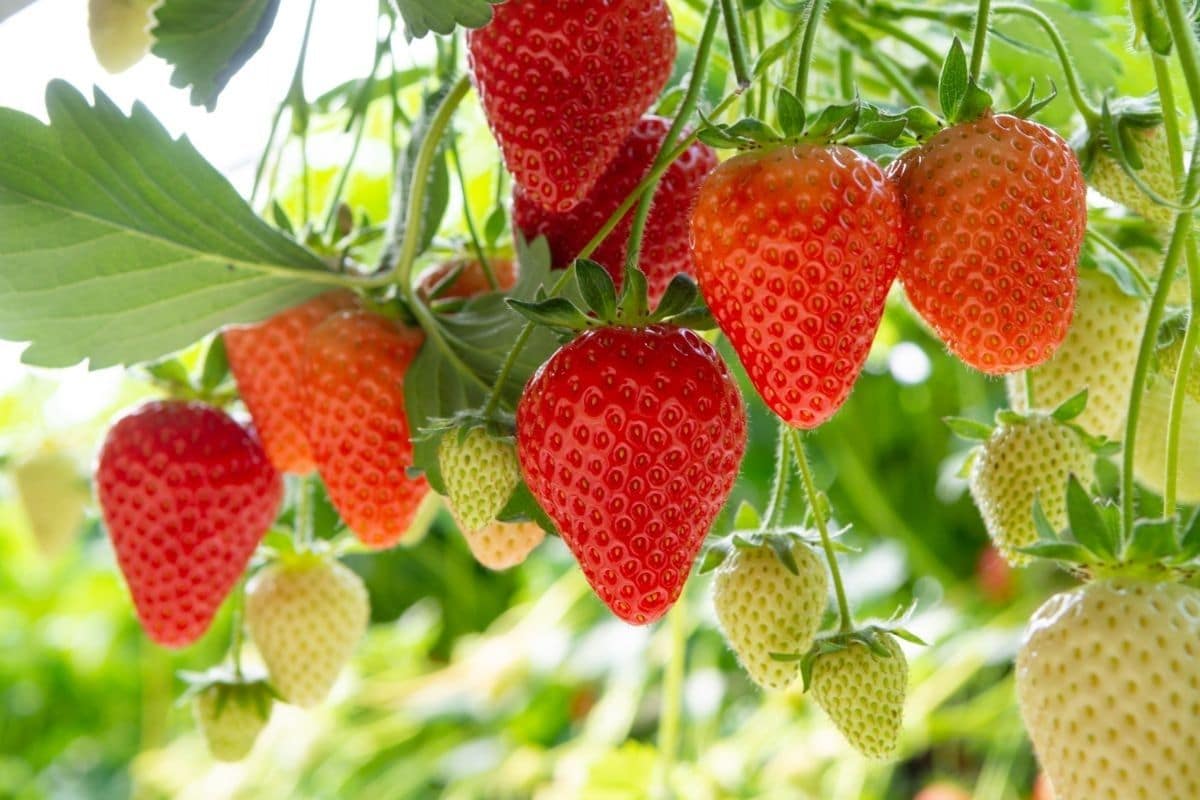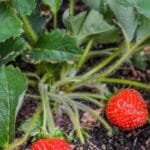Flavorful and easy-to-grow everbearing strawberries produce two main crops of strawberries every year, one in the late spring and one in the early fall, continuous smaller production of strawberries all summer long. Suitable for gardens and farms in USDA Hardiness Zones 3 through 10, everbearing strawberries are perennials that do well in dappled to full sun, although summer sun protection may be a must in southerly and desert locations.
Jump to:
Note. We have a huge, general growing strawberries guide over here. If you are interested in growing everbearing strawberries and this is your first time growing strawberries, then you might want to first read that article and then continue with this article.
What is an Everbearing Strawberry?

Strawberries come in three major types: June-bearing, day-neutral, and everbearing. June-bearing strawberries set fruit as the days get longer in the spring and produce their harvest for the year just before the longest days of the year around the summer solstice. Day-neutral strawberries are like everbearing strawberries in that they produce some fruit all summer, although they will put on a heavier harvest in the late spring and early fall. Everbearing strawberries produce consistently throughout the summer.
Everbearing Strawberry Seeds and Plants
[amazon bestseller=”everbearing strawberry” items=”4″ grid=”2″]
Preparation for Planting Everbearing Strawberries
Everbearing strawberries need consistent sun throughout the growing season. That’s why it’s important to select a site for your strawberry bed that gets at least six hours of sun every day. It’s OK to get dappled sun in the late afternoon if the bed gets strong sunlight in the morning. If you live in an area where summers are hot and dry, protected from the afternoon sun will make sustaining your summer crop a lot easier. Just don’t try to grow everbearing strawberries in full shade.

Home gardeners need to provide everbearing strawberries with most of the nutrients they will need for the whole growing season before they set out plants. The best way to do this is to work in 1 or 2 inches of well-aged compost into the top six inches of the growing bed. Compost provides nitrogen on a slow-release basis, keeping strawberry plants fed without risk of fertilizer burn. It helps give everbearing strawberry plants a foliar feeding with a low-nitrogen liquid fertilizer (always diluted according to directions on the label) to give them an extra dose of trace minerals to help the berries concentrate acids for tartness and sugars for sweetness.
It is always a good idea to keep the growing bed a manageable size. A bed that is three feet across with two-foot walkways on either side is ideal.
What varieties of everbearing strawberries work for home gardeners?
Home gardeners and commercial growers alike praise Ozark Beauty. It is unusually disease-resistant, and it produces luscious big berries filled with sweet flavor. If you want to hold over your strawberries for production next year and you live in a location that gets cold winters, Ogallala and Fort Laramie are good choices. If you are growing everbearing strawberries through a hot summer, try Seascape — although any variety will be a challenge to sustain through a long, hot summer.
It’s OK to fertilize everbearing strawberries with one pound of 10-10-10 fertilizer per 100 square feet of strawberry bed early in the year, working the fertilizer into the soil before planting, but be careful about using commercial fertilizer during the growing season. Foliar sprays with fish emulsion or seaweed diluted with water are usually safe.
It’s always helpful to know your soil’s pH. Testing supplies are available at any garden center and online. If your soil has a pH below 5.8, add three pounds of lime per 100 square feet before planting. If your soil has a pH above 7.0, be sure to use compost to lower the pH of the growing medium. Replacing about a third of the compost with peat moss usually gets the pH down to a level strawberries like.
Setting Out Your Everbearing Strawberries
If you are setting out strawberry plants you get from the nursery in pots, give them a gentle watering about an hour before you set them out. This activates the roots to be ready to receive nutrients from the soil. If you are setting out bare-root strawberry plants, give the bottom third of the root mass a quick trim. This makes it easier to fit the plant into the hole and stimulates root growth. You should rehydrate dry roots by immersing them in water for at least 20 minutes but no longer than an hour before planting in the strawberry bed.

Everbearing strawberries need plenty of room to grow. Crowding plants set them up for fungi, mites, and insects. Set them out about 15 inches apart in their bed. The hole you dig for your strawberry plant should be about twice as wide as the root ball of the plant and deep enough for the roots to stretch out without becoming bunched up together.
Place the plant so the crown of the plant, where the stems emerge, is at the same level as the surface of the soil. Fill over the roots of the plant with soil and water them in, making sure that the crown is neither elevated above the surface of the growing bed nor buried in the soil. Mulch around the plants, but not cover the crown, to prevent weeds.
Maintaining Your Everbearing Strawberry Bed
Strawberries need either an inch of rain or an inch of irrigation water every week during the growing season. It’s important not to let the ground around them get soggy, and it’s important to keep them from drying out completely. As we’ll cover a little later, it’s best to give your everbearing strawberry plants “just barely enough water” for the highest quality fruit.
Don’t work the fertilizer into the soil once your strawberries have begun to grow. This can disturb their roots and greatly reduce production.
Everbearing strawberries don’t produce a lot of runners, the stems that grow out from the plant can produce a baby plant. To keep your strawberry plant’s energy focused on producing strawberries, pinch off long runners when you see them. It’s best to pinch off runners at the point where they emerge from the stem.
Overwintering Everbearing Strawberry Plants
If you live in a place where freezing temperatures are common during the winter, cover your everbearing strawberry plants with mulch right after the first hard freeze. Remove the mulch in the spring after you have had your last expected hard freeze or when new leaves begin to appear from the crown at the center of the plant.
You’ll probably need to replace everbearing strawberry plants every three years to maintain good production.
Unexpected But Useful Facts About Everbearing Strawberries
Everbearing strawberries are sensitive to colors in overhead lighting and colors in plastic tenting used to protect them from the weather. According to a team of research scientists at two universities in Japan, exposing everbearing strawberries to blue light causes them to produce more berries (but smaller berries) and exposing everbearing strawberries to red light causes them to fruit earlier (with larger berries).
Dutch scientists have confirmed that growing everbearing strawberries just a little on the dry side causes them to produce more natural sugar so they taste sweeter. In their study, strawberries of the Flamenco variety that were grown under “minimal drought stress” had 10 to 30 percent more natural sugar. Eve’s Delight strawberries grown under drought stress had 70 to 80 percent more sugar than strawberries that were watered normally after the fruit had begun to set.
With everbearing strawberries, English scientists have discovered, spider mites tend to attack the same part of the plant as they travel across the bed. This means that if you find spider mites near the crown of one plant, you should expect to find them near the crowns of other plants. Or if you find spider mites in folded leaves on one plant, they are likely to show up in folded leaves of the next plant.










Judy says
Can I remove baby plants from runners to use for a new bed and would I do that in the fall or spring? Everbearing plants.
Mary Ward says
Yes, you can. Fall is a good time and gets you ahead, but it can also be done in the spring.
Warren sybrandt says
Hello I live in yuma az, very hot here but want to plant everbearing strawberry plants orzak outside or house plants.
Whats the best soil prep,and care for the plants shade is manmade but temperatures are 110 to 120 ,I appreciate any suggestions thanks
Junelle Erickson says
Would like the names of everbearing strawberry that seemed to have white flowers in spring into summer and then pink flowers in the fall. Very sweet one in neighboring area and would like to get.
Lynette Manning says
I planted “Seascape” everbearing plants in 2016. I had beautiful plants and berries. This year the plants mutated growing from one plant as many as 5 or 6 all hitched together as one plant. I pulled up the affected plants and the roots were all dark. Some had very good berries, but some rotted or dried up. Was this because of getting so hot and then cool weather? I am replanting the bed. I always water when needed. Thank you, Lynette
Judy says
I have the same issue, with the seascape everybearing plants all clumping together with dark roots. If I dig up the clumps should I separate them into separate plants and discard the hard dead looking parts?
Mary Ward says
If they are truly separate plants, that would be best. The dark head might be crowns getting pushed out and dried up.
Sandra says
We accidentally managed to have a bed that has been great for several years in a row with little help. However, they have become overgrown. We have pulled some plants out, but the bed looks awful. What is the proper way to way to get control and have more berries? They have almost stopped bearing.